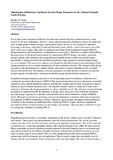Optimization of rainwater catchment systems design parameters in the arid and semiarid lands of Kenya

View/
Date
1999Author
Ngigi, Stephen N
Type
PresentationLanguage
enMetadata
Show full item recordAbstract
It is evident from experiences in Kenya that rainwater could be the long awaited answer to water
scarcity in the next millennium. However, some technical and policy hindrances need to be addressed.
Lack of appropriate technical designs, among other factors, has led to low adoption of rainwater
harvesting technology, especially in Arid and Semiarid Lands (ASAL), where rainwater is one of the
most viable water supply. This calls for optimisation of Rain Water Catchment Systems (RWCS)
design parameters and formulation of comprehensive water policy. Therefore, to address this problem,
the paper focus on the hydrological criteria for determining RWCS design parameters, especially
storage capacity and catchment area, using historical rainfall records of Kibwezi rainfall station.
Specifically, a design procedure for determining optimal design parameters and developing design
curves is outlined. The mass curve analysis was adopted for the determination and optimisation of the
design parameters due to outlined inadequacies of most empirical formulae. The strength of the design
procedure is the determination of optimal design parameters at various reliability levels of rainfall
amount and distribution. The analysis of design parameters revealed that the catchment area and the
storage capacity are affected by variations in rainfall amount and distribution respectively.
In addition, the paper proposes a procedure for incorporating rainfall distribution, which has been
consistently ignored in the designs of RWCS. The proposed procedure involves adjustment of monthly
rainfall by using rainfall distribution indices such that the monthly rainfall totals correspond to annual
rainfall at a given rainfall reliability level. The adjusted monthly rainfall is subjected to mass curve
analysis to determine the design parameters at various reliability levels. The selection of optimal design
parameters is simplified by the development of design tables and curves from which the catchment
area and storage capacity for a specific water demand can be easily obtained at various reliability
levels. The paper concludes by proposing some recommendations to promote utilisation of rainwater,
and adoption of RWCS technology in Kenya. Therefore, the developed procedure could enormously
contribute to the adoption and implementation of optimal RWCS designs, and hence supplement
government efforts towards meeting ever increasing water demand. The procedure could also be used
to evaluate the reliability of existing RWCS.
Citation
Stephen N. Ngigi (1999). Optimization of rainwater catchment systems design parameters in the arid and semiarid lands of Kenya. Proceedings of the 9th International RainwaterPublisher
Department of Agricultural Engineering University of Nairobi
